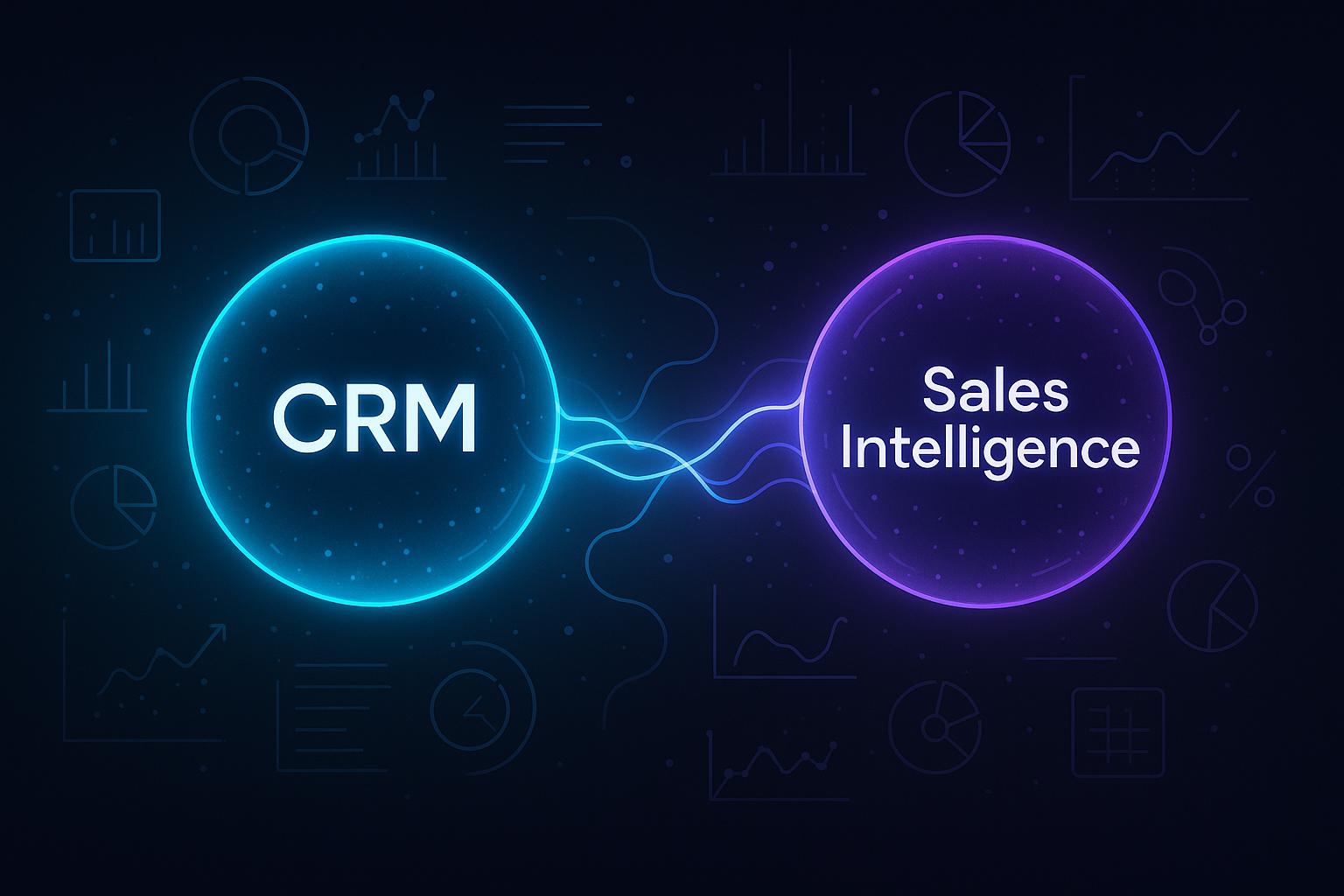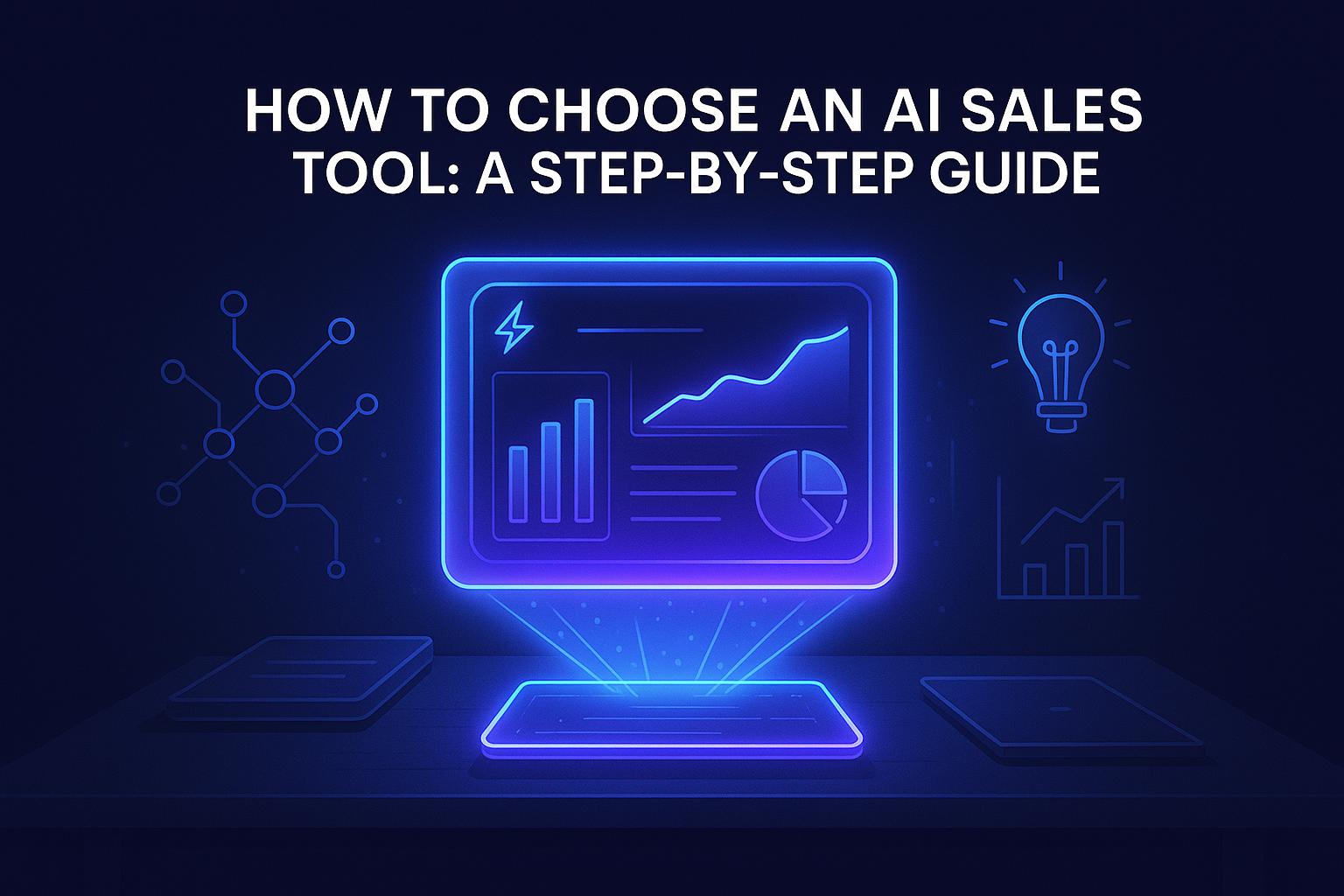AI-powered sales tools are transforming how businesses operate by processing real-time data to deliver instant insights. These tools help sales teams respond faster, improve accuracy, and streamline workflows. Here’s a quick overview of how they work and their benefits:
- Instant Insights: Analyze customer interactions and market shifts in seconds.
- Automated Recommendations: Get real-time suggestions tailored to leads and opportunities.
- Dynamic Forecasting: Continuously updated sales predictions improve decision-making.
- Predictive Analytics: Spot trends and buyer behavior to stay ahead.
Key Platforms at a Glance
| Platform | Strengths | Challenges |
|---|---|---|
| Clari | Real-time pipeline management | Complex setup, limited customization |
| Salesforce Einstein | Predictive insights, CRM integration | High cost, steep learning curve |
| Gong | Conversation analysis, coaching | Storage limits, language support |
| HubSpot | Intuitive CRM, real-time updates | Basic AI features, API restrictions |
| Seamless.AI | B2B contact database, email validation | Export restrictions, slower refresh |
Takeaway: Whether you're a small business or an enterprise, real-time AI tools can enhance sales performance by delivering actionable insights when you need them most. Choose a platform based on your specific needs, budget, and industry focus.
How AI Agents Are Changing Sales Teams and Their Workflows
How Real-Time Data Works in AI Sales Tools
AI-powered sales tools thrive on real-time data integration, enabling them to process and analyze information as it comes in. This seamless operation is made possible by a layered system working behind the scenes.
Data Collection Layer
At the foundation, data is constantly gathered from various customer interactions - whether it's website visits, emails, or social media engagements. This ensures the system always reflects the latest customer behavior.
Synchronization Engine
When new data is available, the synchronization engine ensures updates are instantly shared across all modules. This keeps every part of the system aligned with the most recent information.
Real-Time Analytics Processing
Incoming data streams are fed into analytics engines equipped with advanced algorithms. These engines handle tasks like evaluating customer sentiment during conversations, identifying buying signals from different channels, dynamically updating sales forecasts, and fine-tuning lead scores as customer activities shift.
Automated Decision Support
Real-time insights lead to immediate, personalized actions. For example, sales teams can be alerted to a high-priority lead or provided with tailored recommendations during a live interaction.
To handle heavy data loads without delays, the system uses advanced caching and predictive loading techniques. This ensures the tools remain responsive, transforming raw data into actionable insights that help sales teams stay agile in a fast-paced market.
1. Clari Pipeline Analysis System

Clari takes the concept of real-time data integration and applies it to pipeline management in a way that's both practical and impactful. Its standout feature, the Flow module, offers dynamic visualizations of deal movements, giving sales teams a clear view of how opportunities progress through different stages. Let’s break down what makes this system so effective.
Clari’s AI-powered analytics boasts an impressive 98% accuracy in revenue forecasting. This precision is possible because it pulls data from a variety of sources, including CRM systems, emails, calendars, and sales activities, ensuring a comprehensive view of the sales process.
Here’s a quick look at the core data sources Clari integrates:
| Data Source Type | Information Captured |
|---|---|
| CRM Systems | Deal status and contact details |
| Email Communications | Customer interactions and follow-ups |
| Calendar Data | Meeting schedules |
| Sales Activities | Actions taken by sales representatives |
Clari also offers the Groove tool, which provides deeper insights by analyzing customer interactions. It identifies key factors like sentiment, pain points, and potential buying signals, helping teams fine-tune their strategies.
By automating the collection of data from CRMs, emails, calendars, and sales activities, Clari eliminates the need for manual entry. This automation means sales teams can monitor opportunities in real time, spot risks early, and even trigger automated follow-ups. It’s a game-changer for efficiency.
One of Clari’s standout features is its ability to deliver instant feedback during sales calls. This allows representatives to tweak their approach in the moment, improving outcomes. For managers, Clari’s customizable dashboards provide a complete, real-time view of team performance and pipeline health. It’s a clear example of how integrating real-time data can revolutionize modern sales operations.
2. Salesforce Einstein Data Processing
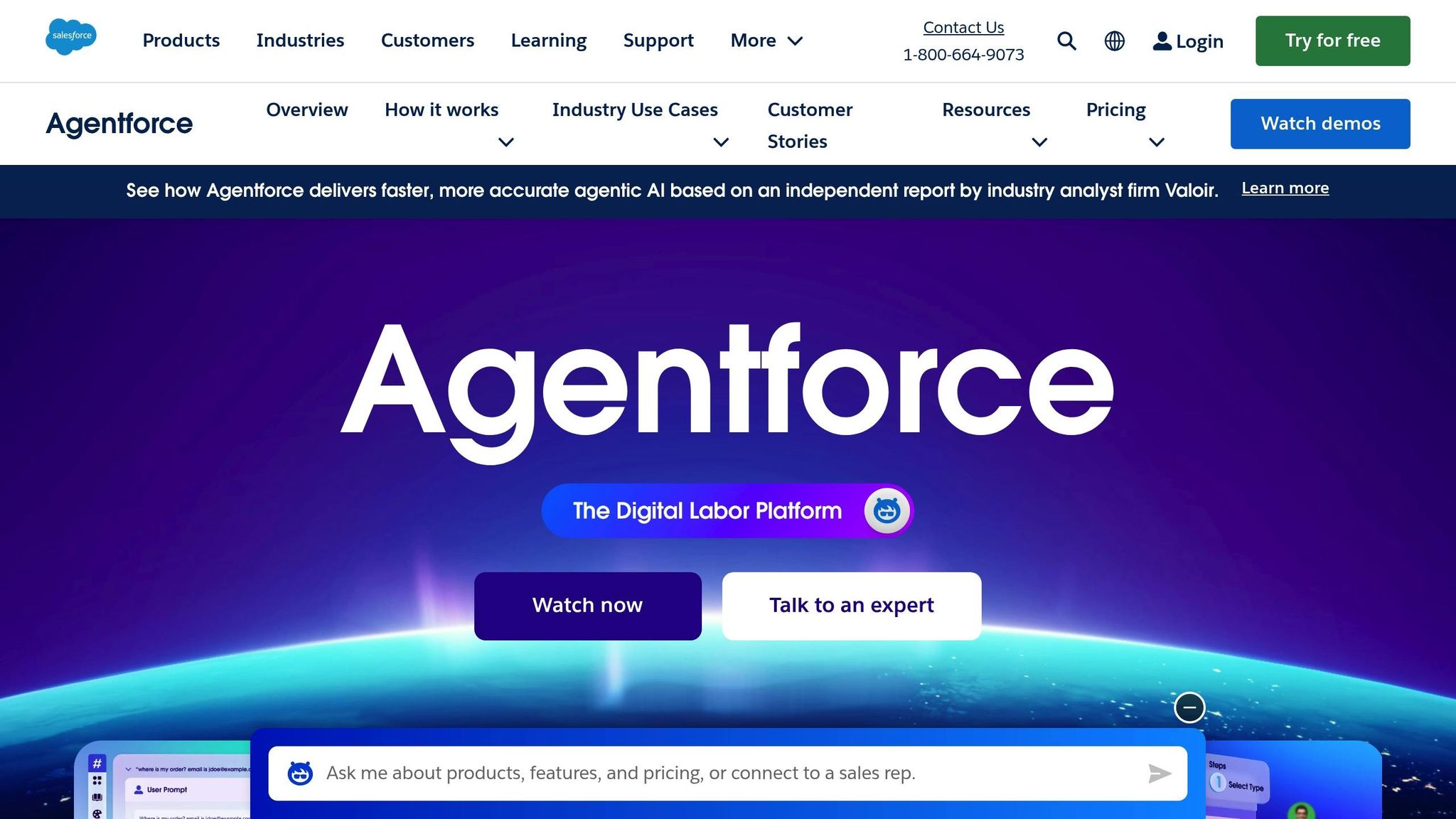
Salesforce Einstein takes AI-driven sales intelligence to the next level, turning massive amounts of raw data into practical, actionable insights. Every day, the system handles an astonishing 100 billion predictions.
Einstein’s data processing framework works seamlessly across multiple integrated channels to deliver real-time insights:
| Data Source | Processing Capability | Real-Time Impact |
|---|---|---|
| CRM Interactions | Tracks deal progress continuously | Instant opportunity scoring |
| Email Communications | Uses NLP to analyze content | Real-time sentiment analysis |
| Calendar Events | Captures activities automatically | Immediate meeting insights |
| Customer Engagement | Tracks across multiple channels | Live buying signal detection |
| Sales Activities | Analyzes performance patterns | Dynamic coaching alerts |
This system automates data capture, cutting down manual entry by 20–30%. That means sales teams can spend less time on admin tasks and more time building meaningful relationships with customers.
Take T-Mobile’s B2B division as an example. By Q3 2023, after adopting Einstein’s capabilities, they slashed their sales cycle time by 42% and generated an extra $4.2 million in quarterly revenue. Jennifer Reeves, their VP of Sales Operations, highlighted how Einstein allowed the team to respond to buying signals three times faster.
Einstein doesn’t stop there. Its AI engine continuously examines customer interactions, uncovering changing purchase behaviors, risks in deals, the best times to follow up, shifts in customer sentiment, and even cross-selling opportunities.
On top of that, Einstein provides real-time coaching, analyzing conversation patterns and offering suggestions based on past successes. Adidas saw the benefits firsthand. Marcus Weber, their Digital Transformation Director, credited Einstein with improving forecast accuracy by 23% after rolling it out to 3,200 retail accounts in January 2024.
Security is another cornerstone of Einstein’s design. It ensures data integrity with encryption both at rest and in transit, all while meeting key compliance standards like SOC 2 and ISO 27001.
3. Gong Data Network System
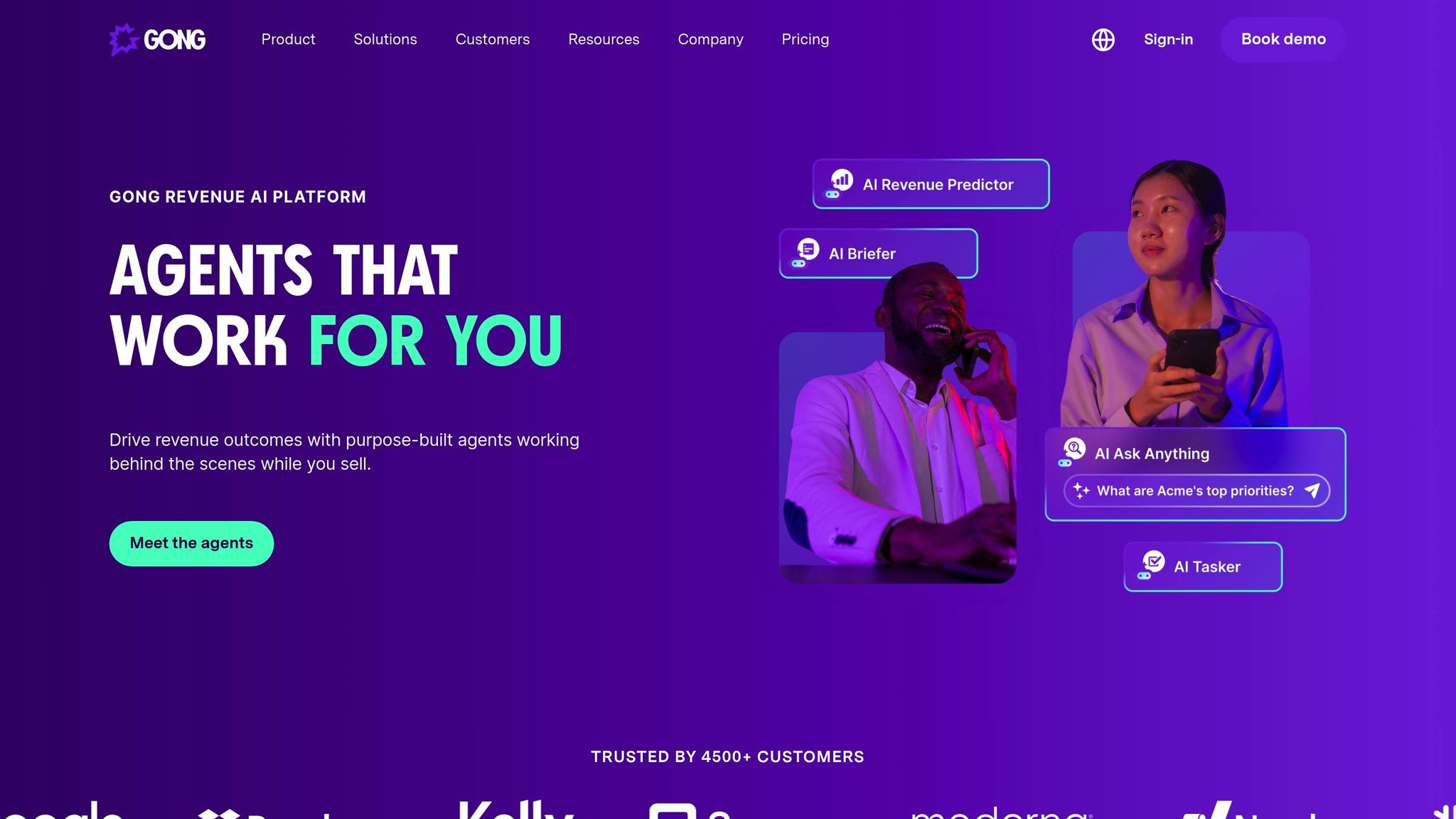
Gong takes real-time sales insights to another level with its Data Network System, processing millions of sales interactions every month to provide insights that teams can act on instantly. By analyzing tone, pace, and engagement, the system delivers a well-rounded view of conversations, helping sales teams stay ahead.
Here’s a snapshot of Gong's real-time analysis capabilities:
| Analysis Type | Real-Time Capability | Business Impact |
|---|---|---|
| Voice Analysis | Tracks tone and pace | Sends immediate coaching alerts |
| Content Processing | Detects topics and keywords | Flags potential deal risks |
| Engagement Metrics | Scores interaction quality | Improves performance strategies |
| Pattern Recognition | Maps successful behaviors | Helps replicate best practices |
| Risk Assessment | Monitors deal health | Enables proactive intervention |
These tools have shown impressive results, such as increasing win rates by 27% and cutting onboarding time by 20%.
Gong’s system is powered by three main components:
-
Conversation Capture Engine
This tool automatically records and transcribes sales interactions across multiple channels in real time, ensuring no detail is missed. -
Analytics Processing Core
The analytics engine identifies key patterns and risks, seamlessly integrating with CRMs to enable quick follow-ups and informed decisions. -
Integration Framework
By connecting directly with CRMs and communication tools, this framework ensures that insights can be acted on immediately.
Beyond these features, Gong’s system also monitors deal health, tracks mentions of competitors, and evaluates customer engagement. This comprehensive approach allows sales leaders to uncover coaching opportunities and scale successful strategies across their teams.
To get the most out of Gong, businesses should fully integrate it with their existing tools and regularly review the AI-generated insights. This method has proven especially effective for U.S.-based sales teams aiming to improve performance.
Finally, Gong prioritizes security with a strong framework designed to protect sensitive data while ensuring it’s accessible to authorized team members. This balance of security and usability makes it a reliable choice for modern sales teams.
sbb-itb-3ed3a29
4. HubSpot Data Integration System
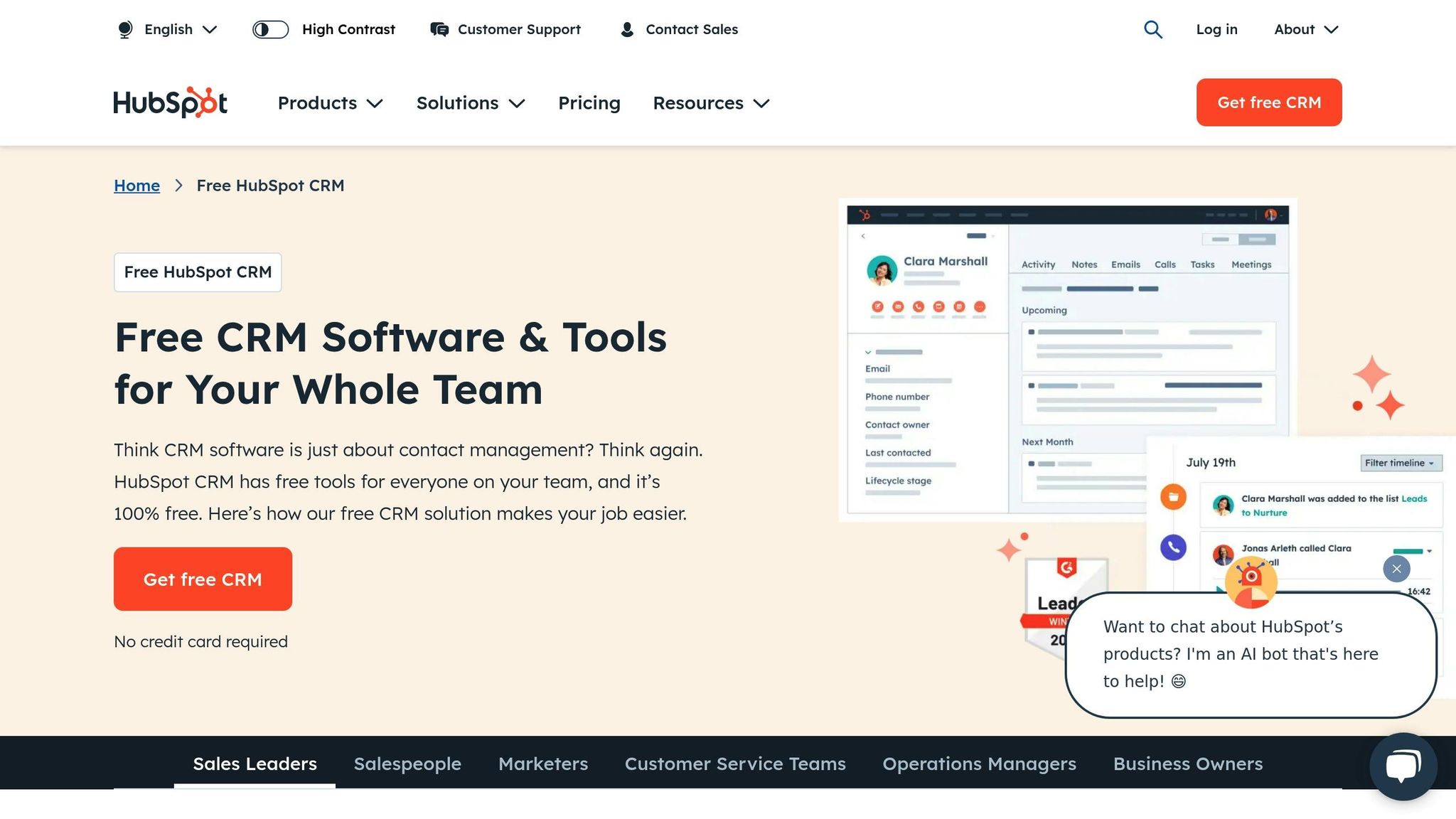
HubSpot takes real-time data integration up a notch by weaving advanced relationship management directly into its workflow. As part of its Sales Hub strategy, the system shifts the focus from routine administrative work to building meaningful customer connections. By using AI-driven tools, HubSpot automates data collection and syncs customer interactions seamlessly. This means sales teams can spend less time on manual data entry and more time on what really matters - building relationships and closing deals.
With real-time synchronization, every customer interaction is instantly updated across the platform. This ensures that teams always have access to the most current data, aligning perfectly with the emphasis on actionable, live information. Additionally, by automating the collection of engagement metrics, HubSpot empowers sales teams to take a more proactive approach to managing relationships. This method highlights HubSpot's agility in sales operations and sets the stage for a deeper comparison with other platforms in the following sections.
5. Seamless.AI Contact Database

Seamless.AI is designed to simplify B2B contact retrieval with its AI-powered search engine, which manages a massive database of over 1.3 billion B2B contacts. By leveraging real-time data processing, the platform ensures sales teams have access to accurate and current information.
One of its standout features is the ability to validate more than 1.8 billion business emails and 414 million phone numbers in real time. This automated verification process eliminates the need for manual updates, giving teams more time to focus on closing deals.
The platform also integrates seamlessly with popular CRMs like Salesforce, HubSpot, Salesloft, Outreach, Pipedrive, and Dynamics. Madelyn M., a Sales Operations and Marketing Manager, highlights the ease of use:
Seamless.AI integrates really well with our CRM database and it makes for quick and easy contact imports.
In addition to its extensive contact database, Seamless.AI maintains up-to-date information on over 121 million companies and websites. As CEO Christal B. explains:
I love that the info you get access to is in real-time and not outdated. The setup is streamlined and it's easy to implement. It is also easy to train others to use without having a long learning curve.
With these capabilities, Seamless.AI plays a key role in streamlining sales workflows and ensuring teams work with reliable, real-time data.
Platform Strengths and Limitations
Real-time data capabilities highlight each platform's specific strengths and challenges in improving sales performance.
| Platform | Strengths | Challenges |
|---|---|---|
| Clari Pipeline Analysis | Advanced pipeline forecasting, real-time deal risk assessment, automated opportunity scoring | Complex setup, reliance on historical data, limited customization options |
| Salesforce Einstein | Seamless CRM integration, predictive lead scoring, multi-source data processing | Steep learning curve, high resource demands, premium pricing |
| Gong Data Network | Real-time conversation analysis, pattern recognition, call analytics | Storage limitations, dependency on network stability, limited language support |
| HubSpot Data Integration | Intuitive interface, marketing integration, automated data enrichment | Basic AI capabilities, fewer analytics options, API restrictions |
| Seamless.AI | Verified B2B contact database, email validation, CRM compatibility | Search query limits, export restrictions, slower refresh rates |
These comparisons reveal the trade-offs organizations face when choosing a platform, providing a foundation for further evaluation.
Key Considerations for Platform Selection
When evaluating these tools, it’s important to weigh several critical factors:
- Processing Speed: The ability to process real-time data efficiently impacts how quickly sales teams can act on insights. Faster platforms offer more immediate decision-making advantages.
- Integration and Scalability: Some platforms shine in consolidating data from various sources, while others are better suited for specific integrations. Performance may vary as data volumes increase, so scalability is a key factor.
- Resource Requirements: Each platform demands differing levels of processing power, memory, and network capacity. Ensuring compatibility with your existing infrastructure is crucial for smooth operation.
Choosing a platform that strikes the right balance between these factors ensures that real-time insights effectively support agile and informed sales decisions.
Key Findings and Recommendations
Based on the platform comparisons outlined earlier, here are some tailored findings and suggestions to help you choose the best solution for your business.
The right platform for you will largely depend on your company’s size and the specific needs of your industry.
Enterprise-Level Solutions
For large businesses, platforms that offer powerful real-time processing and smooth integration are essential. Tools like Salesforce Einstein and Clari stand out by providing timely insights that help drive strategic decisions.
Mid-Market Solutions
Mid-sized companies often prioritize affordability without sacrificing performance. HubSpot's Data Integration System is a great fit for businesses that need effective data enrichment without unnecessary complexity.
Industry-Specific Applications
Different industries have unique demands when it comes to handling real-time data. Here's a quick look at some recommendations:
| Industry | Recommended Platform | Key Advantage |
|---|---|---|
| Technology | Gong Data Network | Transforms customer conversations into actionable insights |
| Financial Services | Clari Pipeline Analysis | Helps manage pipelines effectively and assess risks |
| Healthcare | HubSpot Integration | Focuses on secure data processing and compliance |
| Manufacturing | Salesforce Einstein | Combines diverse data sources for streamlined operational insights |
These recommendations highlight how industry-specific needs influence platform selection.
Implementation Priorities
When rolling out AI-powered sales tools, businesses should focus on the following areas to ensure success:
- Data Quality Management: Set up strong data validation processes to ensure inputs are accurate.
- Network Infrastructure: Build a reliable network capable of handling high-performance data processing.
- User Training: Offer comprehensive training programs to help your team get the most out of these tools.
ROI Considerations
Integrating real-time data capabilities can speed up decision-making, fine-tune strategies, and improve overall productivity. By aligning your platform choice with your business's specific goals, you can make the most of your investment in AI-powered tools.
FAQs
How do AI-powered sales tools maintain data security and comply with standards like SOC 2 and ISO 27001?
AI-powered sales tools take data security seriously by employing measures like encryption, access controls, and regular audits. These tools are designed to comply with established standards such as SOC 2 and ISO 27001, adhering to strict protocols for how data is handled, stored, and processed.
Many vendors also pursue independent certifications and assessments to prove their commitment to these standards. This extra step helps reassure users about the safety and reliability of their data. It's a good idea to review a tool’s security documentation to confirm it aligns with your organization's specific needs.
What should businesses consider when selecting an AI-powered sales tool that fits their industry and size?
When choosing an AI-powered sales tool, it's important to ensure it aligns with your business's unique requirements. Look for tools that can streamline repetitive tasks, improve customer engagement, and work smoothly with your current systems.
You’ll also want to evaluate features like real-time data analysis, adjustable workflows, and the ability to scale up as your business expands. Selecting a tool that fits your industry and company size can help you get the most out of your investment while boosting overall efficiency.
How do AI sales tools use real-time data to help sales teams work smarter and close deals faster?
AI-powered sales tools use real-time data to boost the efficiency and effectiveness of sales teams. These tools handle tasks like updating CRM records and sorting leads automatically, freeing up team members to concentrate on connecting with clients and closing deals.
With real-time insights, sales teams can tailor their approach to match customer needs and preferences in the moment. This leads to more engaging conversations and better conversion rates. The result? A smoother workflow that saves time while also enhancing customer satisfaction.

